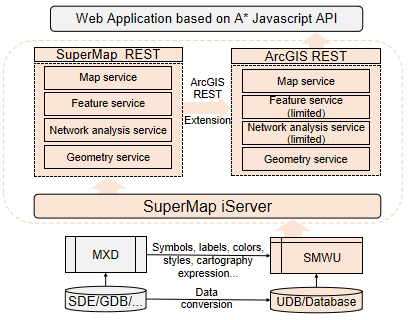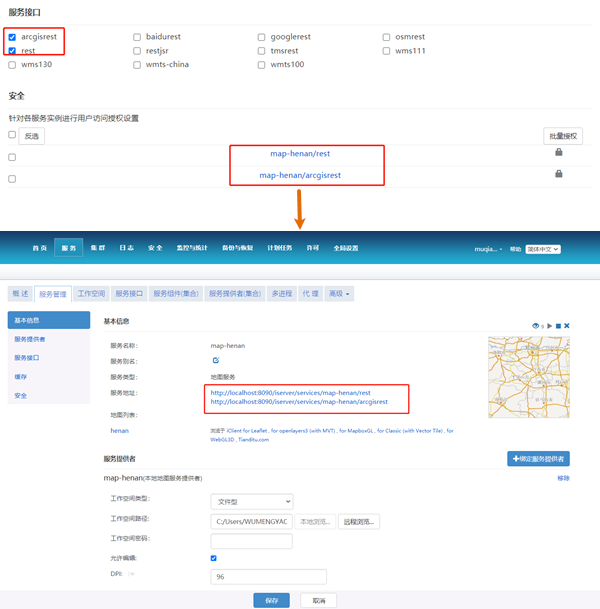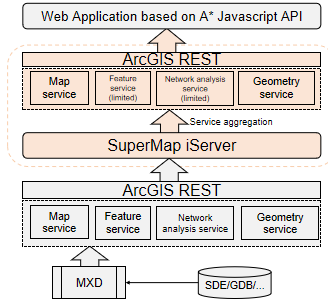GIS service is a set of software functional entities related to geographical information in a network environment. It exposes encapsulated functions through interfaces, uses Web technology to expand and improve GIS applications, and has strong user interaction capabilities. GIS service types can be divided into: spatial data publishing, spatial query retrieval, spatial model services, and Web resource organization.
 ArcGIS Service Type
ArcGIS Service Type
ArcGIS Server is a server-based GIS product that is used to build enterprise-level GIS applications and ready-to-use services that are centrally managed, such as map services, feature services, processing automation services, image services, and geographic data services, geocoding services, network analysis services, spatial analysis services, and provides open interfaces for data publishing, data sharing, and model analysis.
 SuperMap Service Types
SuperMap Service Types
SuperMap iServer is a cloud GIS application server product based on a cross-platform GIS kernel. This product provides full-featured GIS services for network clients through services, such as map services, data services, spatial analysis, network analysis, and traffic transfer, 3D services, machine learning, data science, streaming data services, etc. It can also be personalized through service expansion to provide rich choices for different user needs.
SuperMap iServer provides a system monitoring and statistics module for monitoring the running status of the server, concurrent access, hotspot services, etc. It can monitor and count the current load of the server, the load status of the cluster system, and the performance of each part of the code when the server responds to map requests, the access history of statistical service instances and user, and settings to notify administrators via email when errors or warnings occur in the system. By monitoring and counting the running status and concurrent access of the SuperMap iServer, you can better understand the server's operation and load, and assist system administrators to adjust and optimize the server and service content in a more targeted manner.
SuperMap iDesktopX provides two forms: publishing service and forwarding service to realize the migration of ArcGIS services.
 Publish Service
Publish Service
Convert ArcGIS datasource or map document to SuperMap type, then use SuperMap iServer to publish the service, and then perform service conversion. Currently, three services of ArcGIS Rest are supported, including ArcGIS REST feature service, ArcGIS REST map service, and ArcGIS REST network analysis services.

Functional Entrance
Data Migration >ArcGIS Data Migration > SuperMap Service > ArcGIS Service.
Parameters
- iServer URL: Enter the iServer address to publish service. Click the drop-down button of the combo box and select "New Connection" to open the "Login SuperMap iServer" dialog. Enter the service address, user name and password. After successful login, the program will automatically save the connected address for further quick login.
Note: If iServer service is not started or the administrator account and password are entered incorrectly, you will not be able to log in normally. Please confirm whether the link information is correct and log in again.
- Workspace : Select the workspace file (*.smwu) to be published, and the program will read relevant data according to the file path.
Upload Local File: set whether to upload local files. If you do not upload local files, the service will become unavailable when the file directory changes.
- REST Service: Supports publishing as REST service types, including ArcGIS REST feature service, ArcGIS REST map service, and ArcGIS REST network analysis service. For a detailed introduction to REST service types, please see REST Service.
- Parameter Settings: The "Editable" checkbox in the options is used to control whether the data can be edited. After checking the "Editable" checkbox, the published data can be edited through other clients, such as creating a new dataset, modifying the name of the dataset, etc.
After executing the publishing service, the output window will prompt whether the publishing is successful. If the publishing is successful, the output window will display the published service address and browsing address. After the release is successful, log in to the SuperMap iSever service management interface and check the arcgisrest option for service conversion, and you can get two service addresses.


 Forward Service
Forward Service
ArcGIS-based datasources or map documents are connected to ArcGIS services through SuperMap iServer. Currently, three service types of ArcGIS REST (feature services, map services, and network analysis services) can be forwarded to SuperMap service types.

Functional Entrance
Data Migration >ArcGIS Data Migration > ArcGIS Service > SuperMap Service.
Parameters
- iServer URL: Enter the iServer address to publish service. Click the drop-down button of the combo box and select "New Connection" to open the "Login SuperMap iServer" dialog. Enter the service address, user name and password. After successful login, the program will automatically save the connected address for further quick login.
- ArcGIS Service Type: Select the ArcGIS service type to be forwarded. Currently, three service types are supported: ArcGIS feature service, ArcGIS map service, and ArcGIS network analysis service.
- Source Dataset > Service Address: Enter the connection address of the ArcGIS service and ensure that the current connection address is accessible locally, otherwise the service will not be forwarded.
- Service Type: Select the service type forwarded to SuperMap. Currently supported service types include: REST map service, WMS1.1.1, WMA1.3.0, WMTS1.0.0, WMTS-CHINA, Baidu REST map service, Google REST map service, etc. Regarding the service type, please see Publish workspace for detailed instructions.
After executing the forwarding service, the output window will prompt whether the forwarding is successful. If the publishing is successful, the output window will display the published service address and browsing address. You can copy the service address and open the iServer REST service as a web datasource in the current workspace to view. You can also directly click the browse address to view the results published by the service.
